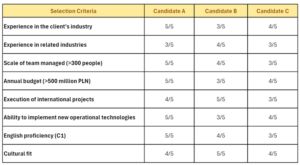The Best Candidate? Effective Selection Methods
Making hiring decisions is one of the biggest challenges every manager faces. How can you choose the best candidate so that hiring translates into the company’s success? This article will help you understand the key aspects of recruitment decision-making and provide practical tips.
Recently, I spent several days visiting flooring stores. With each passing day, I learned more about types of wood, their durability, colors, installation methods… However, instead of making it easier to decide, it only made it harder. Standing in front of the shelf with samples, I wondered: “Will this choice really be the best for years to come?”
Does this sound familiar? Do you feel the same when you must make a decision with long-term consequences? Selecting the best candidate for a key position in a company can evoke similar feelings—especially when all the finalists are highly qualified.
This is why it’s worth analyzing the decision-making process and understanding the mechanisms that govern our choices.
Intuitive vs. Rational Decisions
Psychologists, such as Daniel Kahneman, a Nobel laureate in economics, have noted that most of our decisions are made intuitively—based on emotions rather than facts. Interestingly, we are often unaware of this and believe we are acting rationally. In reality, our brain operates in two systems:
- System 1 – fast and intuitive: this is our automatic reaction, based on instinct and past experiences. It is quick but can be prone to cognitive biases, such as the “halo effect” (e.g., a positive impression from an interview influences our assessment of the candidate’s skills).
- System 2 – slow and analytical: this is the process of conscious thought, which requires time and effort. Here, we analyze data, create lists of pros and cons, and try to make decisions logically.
When choosing a candidate, both parts of the brain work together, but emotions often tip the scales—for instance, when a client selects the person they “clicked” with during the interview, even though another candidate might have slightly better qualifications.
Neuroscience in Decision-Making
Brain research shows that decision-making involves several key areas:
- Prefrontal Cortex – responsible for analytical thinking and evaluating the long-term consequences of decisions. This is where candidate competency data is processed.
- Limbic System – deals with emotions and intuition. Choosing a candidate with whom the conversation felt good is the result of this area’s activity.
- Mirror Neurons – are activated when we see similarities to ourselves in someone. These may make a candidate who shares similar values or communication style seem like a “natural choice.”
Interestingly, the more information we analyze, the greater the likelihood of decision paralysis. This is the so-called “choice paradox”—when we have too many options, it becomes harder to decide, and we fear making the wrong choice.
Selection Criteria – How to Simplify the Decision?
To simplify the decision-making process, it’s worth using analytical tools such as a comparative table. Below is an example of such a table for the position of Operations Director:
Description of Criteria:
- Industry Experience: priority on professional experience in the client’s sector, e.g., energy, manufacturing, FMCG.
- Related Sector Experience: knowledge of sectors adjacent to the client’s industry that can provide valuable skills and perspectives.
- Team Scale Management: number of people directly and indirectly managed by the candidate. Experience managing teams of >300 people is required.
- Annual Budget: managing an operational budget of at least 500 million PLN, corresponding to the size of the client’s organization.
- International Project Execution: number and scale of operational projects carried out in various countries, demonstrating the candidate’s ability to work in a global environment.
- Implementation of New Operational Technologies: experience optimizing processes and implementing modern tools and systems to enhance operational efficiency.
- English Proficiency (C1): fluency in business communication, both written and oral, enabling effective collaboration with international partners.
- Cultural Fit: alignment of the candidate’s values and work style with the client’s organizational culture, assessed during recruitment interviews and observations.
The Outcome of the Final Decision
Making the final decision often brings relief but also raises doubts: “Did we choose the best candidate?” Clients may wonder whether another finalist would have been a better fit. In such moments, it’s worth remembering that the recruitment agency conducted a thorough selection process, analyzing dozens, sometimes hundreds, of profiles before narrowing it down to the top five candidates.
Many clients make decisions partially based on emotions—they choose the person they had the best conversation with or who made the greatest impression on them. This is not a bad approach, as all the finalists are highly qualified individuals carefully selected by the agency. Moreover, recruitment agencies often offer a guarantee on the hired candidate—ranging from 6 to 12 months—which further secures the client and demonstrates the agency’s commitment to the success of the hire.
Summary
Making decisions, especially in recruitment for key positions, is a process that requires both analysis and intuition. Understanding how our brain works and the mechanisms driving our choices allows us to approach this task more consciously. Structured tools, such as a comparative table, help organize information and select the candidate who best fits the organization’s needs.
Choosing the ideal candidate is not just about matching the job description but also finding someone who will collaborate well with the team and support the company’s growth. And once the decision has been made—it’s worth trusting your intuition and recruitment experience to enjoy the success of your choice.
Ewa Borek
Senior Search Consultant
This might also interest you:
Sources:
- Daniel Kahneman, Thinking, Fast and Slow.
- https://pieknoumyslu.com/neurony-lustrzane-funkcja/


